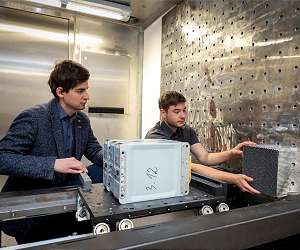Working with partners from industry and research, the German Aerospace Center is developing a climate-friendly energy supply system for ships. It is based on a highly efficient fuel cell system designed to generate heat and power on board. A notable benefit of the cells is that they work with many different fuels. To test the technology, the EU’s NAUTILUS (Nautical Integrated Hybrid Energy System for Long-haul Cruise Ships) research project, led by the DLR Institute of Engineering Thermodynamics, is producing a demonstrator suitable for ships.
Globally, shipping accounts for a significant proportion of greenhouse gas emissions. It also produces sulphur dioxide, nitrogen oxide and soot particles. The International Maritime Organization (IMO) has therefore cut the limits for ship emissions. Its aim is a reduction in the carbon dioxide emission limit of 40 percent by 2030 and 70 percent by 2050 compared with 2008 levels.
Cruise ships are particularly affected by this. Compared with merchant ships, they spend longer in port during stopovers with shore excursions. As a result, they pollute the surrounding area with soot and exhaust fumes. In addition, the emission standards applying in ports are often stricter than those at sea.
Marine diesel – gas engine – fuel cell
The novel fuel cells work with hydrogen, natural gas, methanol or synthetic fuels. This makes the gradual conversion of existing energy systems possible.
Initially, heavy marine diesel oil will be swapped for gas. This will stop the production of nearly all soot particles. “The new fuel cell system and original generator sets with a gas engine will then be in operation at the same time during a transition period,” explains Syed Asif Ansar of the DLR Institute of Engineering Thermodynamics, coordinator of the NAUTILUS consortium. “The fuel cell system can use the same fuel as the gas engines. As a result, numerous components of existing energy systems can still be used. In many cases this is more cost-effective, and conversion is technically easier.”
The fuel cell concept can also be transferred to merchant ships and stationary industry. The NAUTILUS project is one more step along the road to emission-free shipping.
Less soot and carbon dioxide
The NAUTILUS demonstrator is designed to produce 90 kilowatts of electrical power. In comparison with conventional ship generator sets, the demonstrator will emit around 50 percent less carbon dioxide and up to 99 percent less soot.
In addition to the fuel cells, batteries will be used to provide a buffer to cope with peak loads. The DLR Institute of Engineering Thermodynamics is developing new concepts for coupling power circuits to one another for this purpose. The aim is to make the system as efficient as possible in terms of energy and space. “We can achieve electrical efficiencies of 65 percent with the high-performance fuel-flexible cells. The waste heat produced in this process will be fed back elsewhere in the energy system. In this way we can utilise more than 85 percent of the energy input,” Ansar stresses.
Real-world and digital test operation
The researchers want to test the NAUTILUS demonstrator under realistic conditions. To this end they will be simulating voyages, manoeuvres, load variations and the ‘hotel operation’ of a cruise ship. “We will be validating the generator system as if it were actually integrated on board a ship. It will cover the entire process chain, from fuel tank to power consumer. This will also allow us to evaluate the supply system in terms of maritime safety, future regulations and expected service life,” says Ansar.
To do this, the NAUTILUS team is creating a ‘digital twin’ of the generator system. This computational model should make it possible to simulate fully integrated ship energy systems with outputs between five and 60 megawatts. This corresponds to the output requirement of ships with 1000 to 5000 passengers. Systems already installed can be evaluated and structured more efficiently with computer simulations of this kind.
The next step after the initial trial runs of the NAUTILUS demonstrator is already planned. In a second project phase, the DLR Institute of Engineering Thermodynamics and the DLR Institute of Maritime Energy Systems will test the NAUTILUS system together under real-world conditions.
Related Links
Institute of Engineering Thermodynamics at DLR
Powering The World in the 21st Century at Energy-Daily.com
|
We need your help. The SpaceDaily news network continues to grow but revenues have never been harder to maintain. With the rise of Ad Blockers, and Facebook – our traditional revenue sources via quality network advertising continues to decline. And unlike so many other news sites, we don’t have a paywall – with those annoying usernames and passwords. Our news coverage takes time and effort to publish 365 days a year. If you find our news sites informative and useful then please consider becoming a regular supporter or for now make a one off contribution. |
||
|
SpaceDaily Contributor $5 Billed Once credit card or paypal |
SpaceDaily Monthly Supporter $5 Billed Monthly paypal only |
|

![]()
Electric vehicle batteries: The older they get, the safer they are
Graz, Austria (SPX) May 04, 2021
As part of the project “SafeBattery”, a team from Graz University of Technology (TU Graz) has been investigating the behaviour of lithium-based batteries in electric cars under crash loads for the past four years.
“The performance of new battery cells is largely known, so we dealt with the entire life cycle,” explains project manager Christian Ellersdorfer at the Institute of Vehicle Safety. Together with industry partners such as AVL, Audi and Daimler, research was conducted into scenarios that a … read more
